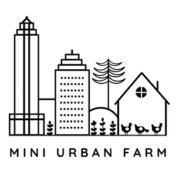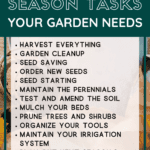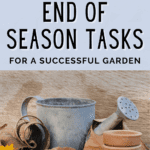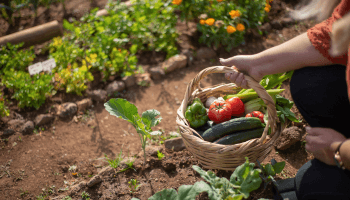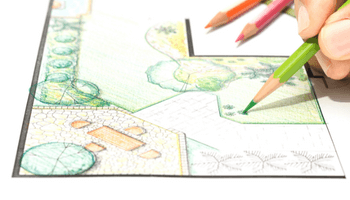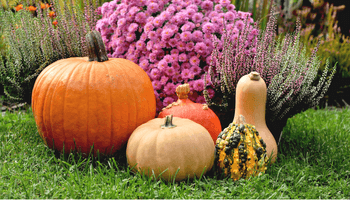The end of each gardening season is always bitter sweet. On one hand, you can look back and enjoy all that you’ve accomplished during the past season. But on the other hand, it’s time to rip everything out and clean up the space. And during this rest period, there are some important end of season gardening tasks to prepare your garden for the upcoming season. So I’ve put together a list of everything that I do each season to prepare for the next one!
End of Season Gardening Tasks:
- Harvest everything
- Garden cleanup
- Seed saving
- Order new seeds
- Seed starting
- Maintain the perennials
- Test and amend the soil
- Mulch your beds
- Prune trees and shrubs
- Organize your tools
- Maintain your irrigation system
- Plan out next season’s garden

Disclosure: This post may contain affiliate links. If you purchase a product through one of our affiliate links we make a small commission from the sale at no extra cost to our readers.
End of Season Gardening
Taking care of your garden in preparation for the next planting season is essential to getting a good harvest.
And while these end of season gardening tasks may seem boring sometimes, they really do contribute to the success of your garden. So I always make it a point to make time for them!
Usually I’ll set aside a weekend (or at least a few hours each day) to complete these chores.
Plus, this has helped me to accomplish one of my biggest gardening goals – growing all my own herbs and veggies!
And for more gardening resources, get access to our free gardening resource library! It will help you fast track your garden and it only takes 5 seconds!
1. HARVEST EVERYTHING
Harvesting your crops is my absolute favorite part of gardening.
And this is especially true at the end of the season where you get to harvest everything that is still left in the ground.
I harvest all my tomatoes, both red and green. All my carrots, no matter how small. And any salad greens that are still growing!
This usually takes me at least a few hours, depending on the season. But, at the end I always have a bunch of veggies to cook for dinner, share with friends and family, or preserve for later!
And since last season I was able to grow all our own vegetables and herbs, I even had a surplus to put in the freezer!
In the upcoming seasons I definitely want to get better at preserving food, but last season I think I did pretty well!
I made:
- Tons of homemade tomato sauce
- Lots of refrigerator pickles
- Quiche to put in the freezer for later (one of my favorite things to do with extra eggs!)
- Froze 3 huge bags of green beans
- Blanched and froze mustard greens
- Made about 3 freezer bags worth of herb bombs
- Dried lots of herbs for tea
2. GARDEN CLEANUP
Ripping out my garden always seems like a daunting task!
Especially since in previous seasons I’ve mostly grown annual plants, leaving the whole garden empty until I replant.
And this is probably the one task that takes the longest for me. But the exact time will depend on how big of a garden you have.
For reference, my garden is about 450 square feet. And last season it took me about 6 hours to get all my plants out!
Of course, during that time, I was removing all the roots, salvaging what I could for compost, and most importantly, harvesting the rest!
I make sure to harvest everything I can – from carrot tops to beet greens!
And then I divide everything up into categories – keep for the kitchen, feed to the chickens, homemade dog food, compost, and trash (usually diseased plants.)
So as much of a pain in the rear as this task is, it’s one of the most important thing to do at the end of the season! Oh and if you want a nifty way to keep track of all your other gardening tasks, be sure to check out my gardening workbook!
3. SEED SAVING
During the harvesting process, there are always a few plants that have gone to seed.
I usually let them go to seed on purpose so I can save them for the next season.
Which means less money spent on seeds. And makes for one of my favorite ways to garden on a budget!
Learning to save seeds is such a great way to keep your garden going each season – for free!
So at the end of every gardening season, I save whatever has gone to seed and put it into little recycled seed baggies for later.
Last season I had enough seeds to plant out half my garden for free, and even shared the extra seeds with friends!
Plus, you’ll want to save surplus seeds for participating in seed swaps throughout the year!
4. Order new seeds
If you haven’t done so already, now is the time to order your seeds for next season’s garden – which is one of my favorite end of season gardening tasks!
Plus, this is usually around the same time that all of the seed catalogues come out – and there’s nothing like browsing through the pages full of new seeds you’ve never heard of before!
So decide on what kind of plants you want to include in next season’s garden, and then be sure to order your seeds early!
Psst…want to fast track your garden? Get access to my FREE gardening resource library and start maximizing your garden today!
5. Seed starting
Along those same lines is starting your seeds for next season.
Now, I garden in Central Florida, which means that my seasons run together pretty much every year. And depending on where you live this might be the same for you.
Or you might have a longer break in between seasons (like places where you have a long winter.)
But no matter where you live, you’ll probably want to start you seeds before the next season. Because wouldn’t you rather have seedlings ready to go when the temperature outside is perfect again?
And if this is your first time starting seeds from scratch, check out this video on how to start seeds!
6. Maintain your perrenials
If you grow a kitchen garden, you’ll likely have more annual plants than perennials.
But if you do grow some perennials in your garden like I do, a great end of season gardening task is to prune them, prepare them for overwintering if needed, and do general maintenance.
For example, every time winter gets close and the temperatures start to drop, I prune my rosemary bushes – which tend to grow a lot throughout the year.
Not only does this help to recharge the plant come spring time, but it also removes some of the leaves that would have died on the plan in colder weather. And I get to harvest all that rosemary for when the plant isn’t growing as well!
7. Test and Amend the soil
At the end of the season you’ll want to amend your soil. Which can include adding in fertilizers, compost, and other nutrients that are lacking beneath the surface.
And it’s easy to skip this step since it’s something that we can’t really see. But it’s important to do this end of season task since during the season the plants have sucked up all the nutrient’s in the soil and they will need to be replaced!
But of course, before you can do that, you need to know what you soil is lacking. Which is where the testing comes in.
And the easiest way to do this is to use an at home soil testing kit.
Then you know exactly what your soil is missing, and you can make sure your plants get exactly what they need!
8. Mulch your beds
Mulching is a great way to keep moisture in and prevent your soil from drying out. But it’s even more essential to mulch at the end of the season if your beds will be empty for a prolonged period of time.
This helps keep nutrients in the soil, keep weeds out, and gives you a better planting space overall next season!
9. Prune trees and shrubs
Just like with taking care of your perennials, you’ll need to prune any trees or shrubs you have. Especially if they’re fruit bearing.
And finding the right time to prune will make a huge difference!
You want to prune fruit trees when they are dormant – usually at the end of fall or right before spring.
This not only helps to remove any dead parts of the tree, but it also promotes new growth.
In fact, pruning is a huge factor in how much fruit you’ll get in the next few seasons!
10. Organize your tools
I don’t know about you, but during the gardening season I’m not always the most…orderly person.
Sometimes I just get in the swing of things and I forget to put my tools back where they go, or care for them properly.
Which is why I’ve included this in the end of season tasks I do!
And not only do I organize my potting bench, but I throw away any broken tools, toss out any cracked pots, and make sure all my tools are nice and clean.
Plus, if there’s anything that needs to be put to rest, now is a great time to invest in new tools for the next season.
And of course, I always replenish my supply of garden twine, tomatoes twists, and fertilizers!
11. Maintain your irrigation system
Two seasons ago I installed an irrigation system (you can see my full set up here.)
And omigosh was it a lifesaver!
Hands down one of the best garden projects I’ve done so far!
It allows me to water my garden when I’m not home, and sleep in when I am too lazy to wake up before noon on the weekends – just kidding (kinda!)
But like everything, your irrigation system will need to be maintained. Or at the very least checked to make sure it’s still running properly.
And the best time to do this is when there are no plants to get in your way!
12. Plan out next season’s garden
Sometimes it can be sad to see your garden so empty at the end of the season.
But, luckily, the end of one season means a new season is coming! And it’s time to plan for it!
So at the end of one/beginning of another, I always map out my new garden with any seeds I’ve saved and the new varieties I’m going to plant.
This is to make sure that the crops can grow well together, don’t crowd each other out, and I have enough seed starts ready to go!
You can watch exactly how I do this in this video about mapping out your garden!
What to do with plants at the end of the season
So you’ve ripped out your garden, taken your harvest, and now you’re left with tons of used up plants.
What should you do with them?
Well, you have 3 options.
One – you can turn them back into the soil to decompose during the off season. This works well for a no-till garden and allows the soil to benefit from extra nutrients in the plant.
But it’s best if the garden has time to rest between seasons if you’re leaving the plants in the beds.
Just cover with compost and let them compost in place.
Two – you can put these plants in compost. This works well for healthy plants and is a great way to give your compost pile a boost.
Of course, you’ll need a decent sized compost bin if you’re going to do this.
And three – you can throw them away. For any seriously diseased plants, it’s best to toss them.
Now, whether of now disease and pests will be eradicated in the compost is a controversial topic. But just in case, avoid adding in any heavily affected plants to your compost.
The last thing you want is to introduce more disease into next season’s garden!
When is gardening season over?
The gardening season end will vary depending on where you live and your hardiness zone.
If you know your zone, it’s easy to look up your frost date and plan backwards for your garden. But basically, your frost date will dictate the end of gardening for most plants (at least the non-frost resistant ones.)
In some zones, like where I am, the opposite is true.
Here in Central Florida we can garden all throughout the “winter” since the temperatures never really go too far below 40 degrees Fahrenheit.
But in summer, when the temperatures get into the 100s, most plants won’t grow too well. So our gardening season is on hiatus between June – August.
I hope this was super helpful! And for more gardening resources, get access to our free gardening resource library! It will help you fast track your garden and it only takes 5 seconds!
Pin end of season gardening tasks!


